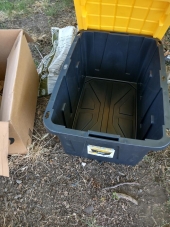
 6
6




“We can complain because rose bushes have thorns, or rejoice because thorn bushes have roses.” — Abraham Lincoln
 9
9




Castaway Compost - Yer Trash be Treasure! castawaycompost.com
 6
6




“We can complain because rose bushes have thorns, or rejoice because thorn bushes have roses.” — Abraham Lincoln
 2
2




 7
7




Jen Fulkerson wrote: Once I've loosened up the soil I started adding stuff. I'm not a measuring type person. I'm trying to add small layers of browns, greens, and soil.
My plan is to turn every two days.( Probably won't happen, but as close as I can manage)
 7
7




If there is one thing the Wizard of Oz has taught me, it is not to trust school teachers on bicycles.
 11
11




Castaway Compost - Yer Trash be Treasure! castawaycompost.com
 6
6




“We can complain because rose bushes have thorns, or rejoice because thorn bushes have roses.” — Abraham Lincoln
 5
5




“We can complain because rose bushes have thorns, or rejoice because thorn bushes have roses.” — Abraham Lincoln
 6
6




Zone 6, 45 inches precipitation, hard clay soil




 2
2




“We can complain because rose bushes have thorns, or rejoice because thorn bushes have roses.” — Abraham Lincoln
 5
5




“We can complain because rose bushes have thorns, or rejoice because thorn bushes have roses.” — Abraham Lincoln
 5
5




Castaway Compost - Yer Trash be Treasure! castawaycompost.com

 4
4




Working toward a permaculture-strong retirement near sunny Sperling.
 3
3




A build too cool to miss:Mike's GreenhouseA great example:Joseph's Garden
All the soil info you'll ever need:
Redhawk's excellent soil-building series





 2
2




 1
1




“We can complain because rose bushes have thorns, or rejoice because thorn bushes have roses.” — Abraham Lincoln











 1
1




Working toward a permaculture-strong retirement near sunny Sperling.
 4
4




Jen Fulkerson wrote: Should I use 1/4", or 1/2 " hardwire cloth? Seems like 1/2" would be good enough. 1/4" would take a lot longer. What do you use?
I have chickens, and had a compost pile in the coop, but that didn't work for me either. The chickens ate a lot of what went into the pile, and spread out what they didn't eat. I never really got compost. It seems like the perfect compost method, but if you don't have a great deal of compostables you just end up with happy chickens, that isn't a bad thing, but doesn't help me get compost for the garden.
I have thought about asking the organic grocery store if I could have there throwaways, then I would probably have enough. I have not followed through with this because I'm not sure I want to take on another commitment. I have a lot of responsibilities, and spare time is hard to come by. But... It would be great not to have to buy so much compost.
Thanks again I appreciate the information and encouragement.
A build too cool to miss:Mike's GreenhouseA great example:Joseph's Garden
All the soil info you'll ever need:
Redhawk's excellent soil-building series





 2
2




“We can complain because rose bushes have thorns, or rejoice because thorn bushes have roses.” — Abraham Lincoln
 1
1




"The one small garden of a free gardener was all his need and due, not a garden swollen to a realm; his own hands to use, not the hands of others to command." -Samwise Gamgee, J.R.R. Tolkien




 1
1





| I agree. Here's the link: http://stoves2.com |





